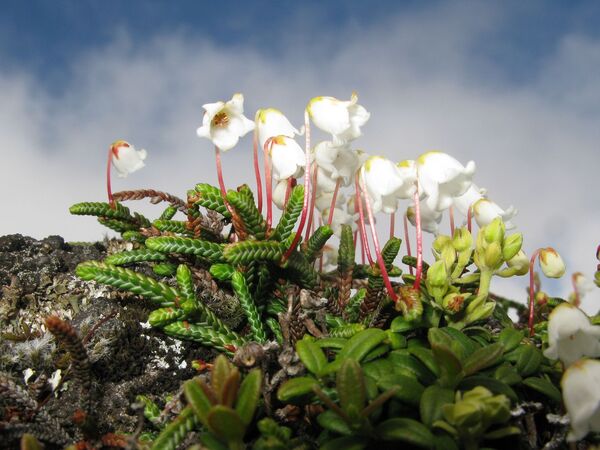When you think of mountain plants, you might envision tall trees or sprawling wildflowers. But nestled among rocky outcrops and high-altitude meadows, there's a lesser-known treasure—Cassiope selaginoides, also known as the "Mountain Beauty" or "Cassiope." This small yet resilient plant is a hidden gem in the world of horticulture, perfect for adding charm and grace to gardens and landscapes.

Cassiope selaginoides, commonly referred to as Rock Cassiope or Mountain Cassiope, belongs to the Ericaceae family. Native to the high-altitude regions of Asia, particularly in China's mountainous zones, this perennial plant thrives in cool, rocky environments. With its stunning bell-shaped flowers and delicate foliage, it brings a soft, ethereal touch to any garden or rocky landscape.
Its natural habitat spans mountain ranges, where it thrives at elevations ranging from 2,000 to 4,500 meters (6,500 to 14,800 feet). Cassiope is known for its adaptability in cold climates, making it an ideal choice for gardeners in cooler regions.
Cassiope selaginoides may be small, but its features make a big impact in landscaping:
Size and Shape: Cassiope is a low-growing shrub, often reaching up to 30 cm (about 1 foot) in height. Its compact form makes it a great ground cover or accent plant in rock gardens.
Leaves: The leaves of Cassiope selaginoides are small, leathery, and lance-shaped, providing a lush, green carpet that contrasts beautifully with its floral displays.
Flowers: The plant’s signature feature is its delicate, bell-shaped flowers, which bloom in shades of white, pale pink, or light purple. These flowers appear in late spring to early summer and often form small clusters, adding a touch of whimsy to your landscape.
Hardiness: One of the standout features of Cassiope selaginoides is its cold tolerance. It thrives in chilly environments and can withstand temperatures as low as -10°C (14°F). This makes it an excellent choice for cold-climate gardeners looking for a low-maintenance, hardy plant.

While Cassiope selaginoides may seem delicate due to its size and soft appearance, it is surprisingly hardy. Here are some key tips to successfully grow this mountain beauty:
Ideal Growing Conditions: Cassiope thrives in areas that mimic its natural habitat—cool, moist, and well-drained soils. Choose a planting location that is somewhat shaded but still receives some sunlight. In extremely hot climates, it’s best to plant it in a spot where it gets partial shade during the day.
Soil: This plant prefers slightly acidic, well-draining soil. A mixture of peat, sand, and loam provides an ideal medium. Avoid heavy, clayey soil that retains too much moisture, as this can cause root rot.
Watering Needs: Cassiope enjoys consistently moist conditions but does not tolerate waterlogging. Ensure good drainage in pots or garden beds to prevent stagnant water. Water regularly during the growing season but allow the soil to dry out slightly between waterings.
Temperature and Winter Care: As a cold-loving plant, Cassiope does best in cool climates and requires protection during the coldest winter months if grown in warmer regions. If you're growing it in containers, consider bringing it indoors or providing extra insulation to shield it from harsh winters.
Fertilization: Cassiope doesn’t require heavy feeding. Lightly fertilize with an organic fertilizer in early spring, just before the growing season begins, to promote healthy growth and flowering. Avoid over-fertilizing, as too much nitrogen can harm the plant.
Cassiope selaginoides is a perfect plant for rock gardens, alpine gardens, or any landscape that aims to reflect the beauty of mountainous regions. Its compact size makes it an excellent choice for adding depth and texture to garden beds without overwhelming other plants.
Because of its low growth habit, Cassiope is ideal for planting between rocks or in stone walls, where it can cascade over the edges, softening the hard surfaces and creating a natural, rugged beauty. It is also a fantastic addition to container gardening—whether as a standalone specimen or as part of a mixed container arrangement.
For gardeners looking to attract pollinators, Cassiope’s delicate flowers are a magnet for bees and butterflies. These gentle blooms provide an essential food source for local wildlife, adding an eco-friendly dimension to your garden.

One of the primary reasons gardeners choose Cassiope selaginoides is its exceptional cold tolerance. In areas with freezing winters, this plant can be an invaluable addition to the landscape. It adds color and life to gardens when most other plants are dormant, and its adaptability to low temperatures ensures it will thrive year after year.
In fact, if you live in a region with harsh winters, Cassiope selaginoides can act as an evergreen ground cover, keeping your garden looking vibrant even in the coldest months. Additionally, it can help prevent soil erosion, especially in mountain landscapes prone to runoff.
Cassiope selaginoides may not be as widely known as other garden plants, but its unique beauty, hardiness, and ability to thrive in challenging environments make it a standout choice for mountain gardens and rock landscapes. Whether you're looking to add a delicate floral accent to your garden or seeking a hardy plant for a cool-climate landscape, this plant is sure to enchant and inspire.
Its low-maintenance nature and striking appearance make it an ideal choice for gardeners of all levels, from beginners to seasoned horticulturists. So, if you're ready to bring the charm of high-altitude meadows into your garden, consider adding Cassiope selaginoides—your own personal mountain beauty.
animal tags: cassiope-selaginoides
We created this article in conjunction with AI technology, then made sure it was fact-checked and edited by a Animals Top editor.